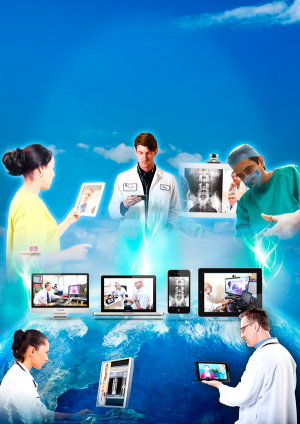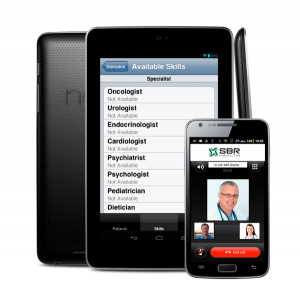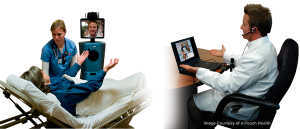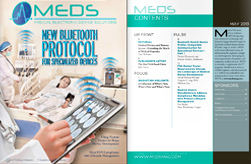Healthcare without Boundaries
Video Communications—from room to desktop to cloud, it’s enabling a new wave of video-enabled healthcare applications.
by Peter Eggleston, SBR Health
Once a complex expensive technology, video communications has gone from being a scarce resource that needs to be scheduled, to one that is inexpensive, pervasive and available to all through the cloud. Advances in soft CODEC technologies, adaptive compression schemes, and out of the box support for video on a wide variety of computing and communication devices are allowing the virtual delivery of health services inexpensively with a minimum of dedicated equipment. The net effect is that now the scarce resources are the clinicians themselves, and the next driver for adoption and growth will not be video technologies, but rather technologies that seamlessly integrate video communications into existing clinical workflows to enhance quality and efficiencies.
For medical device manufacturers, advances in video communication technologies are providing market opportunities that go far beyond simply providing devices that exist only to serve as imaging endpoints. The evolution of cloud-based video communication is enabling manufacturers to provide video-enabled services as part of their products as well as opportunities to provide video applications. The latter are applications built around video devices and platforms that enable a new frontier of interactive treatment. Until now, this was not practically feasible due to the cost and complexity needed for capturing, encoding, routing, transmitting, decoding and displaying a moving image of high quality. Additional hurdles were the need for dedicated networks for carrying this data, the lack of unifying standards for cross network/device interoperability, and the need for dedicated IT staff to set up, operate, support and maintain these systems. However, video has now entered the cloud, and Video as a Service (VaaS) promises to be the next wave of what’s new and hot in cloud technologies.
The notion of cloud-based applications is as old as the computer itself (think timeshare). However what is new is how all the right forces have finally come together: inexpensive HD capable cameras, scalable and adaptable CODECs that can run efficiently on even modestly powered PCs and handheld devices, open standards and services that allow cross-platform interoperability, cheap bandwidth, and new ways to map video routing and switching in the cloud itself. We are now at the precipice where video communications have evolved from the dedicated room-based hardware systems of yesterday, to the software-based desktop and handheld devices of today and on to the cloud-based systems of tomorrow.

Figure 1: VidyoWay, a free cloud-based interconnectivity service from Vidyo, is as easy to set up as a telephone call and frees organizations from network, location and device constraints to enable true “any device, any network, any time” video communications.
Amnon Gavish, SVP Vertical Market Solutions at Vidyo, a company paving the way to the cloud, states that he sees several technology drivers supporting the move toward cloud-based video. First, the quality is moving toward TelePresence, defined as low latency and high definition video, which is crucial to get a natural interaction (Figure 1). “In healthcare this is crucial to get the trust of the patient to get a meaningful interaction—it’s really key not to have the delay of latency so you can carry on a natural conversation,” he explains. The second driver Amnon sees is the change from hardware to software, which cuts the cost of endpoints, switches and routers by many orders of magnitude. “A traditional Tele-room may cost several tens to hundreds of thousands of dollars. Now you are talking about tens of dollars or less for every endpoint by software-enabling desktops, laptops, tablets and mobile devices. This means you can now use existing hardware as endpoints and that opens doors for very large scale deployments. This is essential for health delivery organizations that want to scale up virtual visit programs to their entire patient populations, which can run into the millions of patients.”
Amnon goes on to say that another new technology enabler is the ability to overlay video networks onto existing data networks. “Video communication used to require dedicated networks with quality of service mechanisms,” he explains. “However, these are not scalable. You cannot provide a T1 connection to each patient at home, so you need to overlay the video network with any connection a patient has. And, since these are highly variable networks in terms of quality, you need a way to maintain quality over public networks if you are going to maintain TelePresence quality across existing platforms and networks. If you can do this you can make a huge step to video in the cloud.” Vidyo has accomplished this through the use of scalable video coding technology that allows optimizing the utilization of available network quality and bandwidth, as well as factoring in hardware capabilities of the sending and receiving devices.
Furthermore, to utilize the existing Internet for video transmission and enable VaaS, there is additional “infrastructure” that needs to be put into the cloud. The video CODEC needs to be physically adjacent to the camera itself. Once captured, compressed and encoded, the video signal needs to be routed to the receiving party. Previously, organizations had to purchase, install and maintain portals and routers on their local networks, or even lay dedicated cables to connect them. This required large cash outlays, dedicated IT teams, a lot of operating expense and closed networks. Now, routers can be entirely software-based and run on general purpose servers in the cloud, thereby making the infrastructure much leaner with the net effect of reducing deployment costs by a factor of 100. With these changes, cloud-based services can now be constructed to provide a virtual video infrastructure for any organization, thus enabling low-cost video communications for any person, any device, any network, at any time.
The move toward private virtual clouds as well as public cloud services (e.g., Amazon) makes it easy to put software instances of video routers anywhere and gives you the ultimate flexibility in terms of IT management—you can move your infrastructure at the click of a keyboard. But it isn’t entirely that utopian. Moving to the cloud brings up issues of security, manageability and privacy, which are especially important issues for healthcare institutions. Since they are not operating on networks with secure connectivity and access, VaaS providers need to provide mechanisms for each institution to have its own siloed access to the system in such a way that there is no communication between the virtual video communication networks unless it is intended for them to communicate.
This is why healthcare organizations are hesitant to utilize Skype with their patient populations. What encryption is being utilized? How are the calls being routed? How do you authenticate an end user? How do you prevent an unwanted communication link? In contrast, some companies such as Vidyo provide tools that allow the construction and management of completely secure virtual video networks, and thus many healthcare organizations are starting to develop large scale telehealth programs on their technology platform.
Jonathan Schlesinger, president of Connexus, a provider of on premise and cloud-based video communications, cautions that once institutions go beyond their walls, there are some potential availability caveats that need to be planned for. “Unless everyone is in the same building,” states Schlesinger, “it is a cloud. So, you don’t want to seriously depend on it and not have it be there anymore. Many of the cloud providers have backup systems for failures, but if there is a system wide failure around them, then even though your local network may be up and running, you still can’t get to others.” Schlesinger advises that if you can keep all your infrastructure close to you, this is a good thing. But when healthcare institutions start video conferencing with remote hospitals, clinics and patients in their homes, you are by definition, connecting with people that are not on your network.
Schlesinger goes on to say, “With video conferencing there is no option, you have to be aware of the risks and plan accordingly.” This could include selecting a VaaS provider that offers geo-physically dispersed hosting networks such as the Amazon cloud. Even then, Amazon, Yahoo and everyone in this space have experienced problems with their cloud computing services. These are companies that have spent very large sums of money on getting their act together, and they have experienced major problems even in the last year. If the Internet goes down in the customer’s location or the host location, it is an inconvenience, people do not die. In healthcare, there could be situations that are life threatening. As an example Schlesinger notes, “If Domain Name Sercie (DNS) is down you are in a very difficult situation. There are a lot of DNS attacks and this could affect video connectivity.” Therefore, Connexus has its own DNS servers, and does not rely on the major providers because these are often the very providers being targeted and attacked.
However, the cloud adds some distinct operational advantages to ensure failsafe operation. Where system hardware and software upgrades need to be cautiously managed in on-site deployments to maintain compatibility across sites, in cloud-based systems when you upgrade software it happens simultaneously across the network and compatibility is always maintained. And cloud deployments make it easy to ensure everything is up and running by allowing constant monitoring of endpoint readiness status and connectivity to the network, thus ensuring resources are on line and reachable when needed. Furthermore, it also provides greater connectivity across devices, allowing users to engage in video communications on whatever device they are carrying, rather than relying on being at a specifically, pre-provisioned endpoint. In healthcare where clinicians are especially mobile and needed 24/7, this means clinical resources can be reachable and convertible into a workflow both where and when needed.

Figure 2: Video as a Service (VaaS) is enabling a new category of software termed Video Applications such as this video call and skills routing management solution from SBR Health, shown here running on the ubiquitous iPhone as well as the new Google Nexus7. Now healthcare workers can be brought into video calls on-the-go for less than $200!
In fact, the implications for healthcare are enormous once video communications can be integrated into the care delivery workflow (Figure 2). Traditional hardware-based systems are very inflexible in terms of workflow integration, but once you move into software-based endpoints you open the door to embedding the video into the workflow you are trying to enhance. And therein lies the opportunities for medical device manufacturers who can now leverage the power of VaaS to deliver innovative new products, or video-enable existing devices utilizing Video Web Services APIs. These APIs utilize standards such as SOAP over HTTP and can be easily integrated by developers to create customized video communication experiences that are interoperable with any type of video portals or endpoint applications.
One health IT company creating these customized experiences is SBR Health, a developer of clinical and consumer applications that enable video communications to be utilized seamlessly in the delivery of existing or new care delivery models. When asked about the opportunities VaaS is creating, SBR Health’s CEO and co-founder Christopher Herot explains “Video conferencing offers great potential in medicine, but despite decreasing equipment costs and advances in cloud-based deployments, it still remains difficult to integrate video communication into healthcare workflows. This is creating new opportunities for companies like SBR Health to create applications that support the dynamic nature of healthcare delivery organizations, and solve the problem of how to utilize VaaS technologies seamlessly in existing IT and clinical processes so as to facilitate the delivery of care in a more efficient and effective manner.”
The company’s first product, ResourceManager, is a true enterprise client/server application that intelligently matches patients to care providers to achieve optimal relationship pairing and real-time resource-based workforce scheduling and optimization. This SBR technology when combined with video communications infrastructures enables healthcare organizations to deploy more efficient care models that improve patient satisfaction, increase access to specialists, raise the overall levels of patient care and improve delivery of treatment. “The ResourceManager also allows care providers to work virtually anywhere at any time they choose,” explains Chris, “and gives companies and organizations access to an on-demand global workforce to address staff shortages, serve hard to reach patients, control costs and ultimately increase the level of patient care.”
Another manufacturer leveraging the cloud is InTouch Technologies, a provider of remote presence medical devices. InTouch’s CEO, Yulun Wang, believes cloud-based video communication will profoundly restructure healthcare delivery. “When healthcare providers have high quality and greater access all at a lower cost, then you can deliver care when and where it’s needed at greater efficiencies. While current systems make you be at specific locations at specific times, where these locations have been pre-provisioned and connected, remote presence, cloud-based televideo can instantly connect disparate entities without requiring two IT departments to collaborate in advance.” Wang further explains, “In some instances such as a stroke, it is literally life and death if you can provide the right therapy within a 3 hour window—it is that significant. In many rural and community hospitals, you simply cannot get a stroke neurologist in quickly, which may be one of the contributing factors that make stroke the highest reason for disability in the U.S.”

Figure 3: InTouch Technologies, Inc. leverages cloud-based video conferencing to create FDA-cleared remote presence products allowing physicians to be available on demand whenever and wherever their expertise is needed.
Expanding on the impact that cloud-based systems have on healthcare workflows, Tim Burke, CEO of Quest Systems states, “Hospital IT staff simply have an over abundance of tasks and objectives such as getting electronic medical records systems up and running, and many do not have the expertise for video and do not know where to find it. People who understand how to configure and deploy video communications networks are not in the hospital, but can provide this expertise quickly and cost-effectively from the cloud.” Quest is actually not a newcomer to cloud-based services for healthcare, having provided hosted data and computing solutions to numerous large hospitals for the better part of a decade. Burke further explains, “Hospitals have the expertise of what they are trying to do with virtual care models from a clinical standpoint, but are challenged to design and support this from a user perspective. With VaaS, IT departments can be focused on their clinical end-user requirements and deliver support for virtual care much more quickly.” He goes on to say that VaaS options also allow health delivery organizations to avoid making large commitments to video communication technologies. If they want to try it out they can try this from the cloud using one department or a limited number of doctors with limited investment—they do not need to capitalize equipment and hire people in-house to manage and support such an endeavor.
Burke coaches medical device and HIT solution developers to think beyond video communication as a fixed offering. “The cloud sits out there, it’s a shared environment, the deliverable is fairly static such as an iTunes experience—It’s similar to all users and the user cannot shape the experience of what they want. Unlike embedding static video communication hardware, VaaS does not have to be a canned, here it is, hope it works, experience. By utilizing today’s cloud-based video communications platforms, manufacturers of medical devices can deliver truly unique and flexible experiences and therefore can offer value comparable to an internal, custom-developed solution.”
Connexus, Dallas, TX. (214) 443-2600 www.connexus-evn.com
InTouch Technologies, Santa Barbara, CA. (805) 562-8686 www.intouchhealth.com
Quest Systems, Sacramento, CA. (800) 326-4220 www.questsys.com
SBR Health, Cambridge, MA. (617) 475-1662 www.sbrhealth.com
Vidyo, Hackensack, NJ. (201) 289-8597 www.vidyo.com

